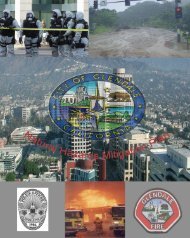Sayre Report - Hazard Mitigation Web Portal - State of California
Sayre Report - Hazard Mitigation Web Portal - State of California
Sayre Report - Hazard Mitigation Web Portal - State of California
Create successful ePaper yourself
Turn your PDF publications into a flip-book with our unique Google optimized e-Paper software.
DRAFT TECHNICAL SPECIALTIST’S<br />
Burned Area Recovery Team (BART)<br />
Resource: Structural Engineering<br />
Fire Name: <strong>Sayre</strong> Fire CA-LFD-1460 December 2008<br />
Author Name: Stevenson Lim, P.E. Transportation Engineer Civil<br />
<strong>California</strong> Department <strong>of</strong> Transportation,<br />
Structure Maintenance and Investigations<br />
100 South Main Street,<br />
Los Angeles, CA 90012<br />
Office (213) 897-0153<br />
I. Resource Condition Assessment<br />
A. Resource Setting<br />
The Burn Area Recovery Team (BART) assigned to the 11,262-acre <strong>Sayre</strong> Fire<br />
inspected the burned area December 1, 2008 through December 12, 2008, as an<br />
entire team and with specialist groups. The <strong>Sayre</strong> fire began on November 15,<br />
2008 and burned a total <strong>of</strong> 11,262 acres on National Forest System (NFS), state,<br />
and private lands. A total <strong>of</strong> 5,513 acres burned on the Angeles National Forest.<br />
Six hundred and thirty six residences were either damaged or destroyed. Majority<br />
<strong>of</strong> the watershed around May #1 & #2, Wilson, Sombrero, Hog, Schoolhouse and<br />
Stetson were burned.<br />
Fires greatly alter physical characteristics <strong>of</strong> hillside slopes, stripping natural<br />
protective vegetation cover, organic litter and removing barriers that stabilize soil<br />
and hold sediment. In addition, chaparral in Southern <strong>California</strong> has a natural<br />
tendency to develop water repellent soils due to their naturally high wax content.<br />
This water repellency dramatically increases after a wildfire because waxes<br />
vaporize and are driven into the soil by heat. Water repellency reduces infiltration<br />
and increases run<strong>of</strong>f rates. According to the U.S. Forest Service (USDA Forest<br />
Service Gen.Tech.Rep.RMRS-GTR-63.2000), peak flows increase 500 to 9,600<br />
percent during the first year after a fire. As a result, burned watersheds generally<br />
respond to run<strong>of</strong>f faster than unburned watersheds and commonly produce flash<br />
floods, debris flows, and landslides, which can be devastating to property and<br />
human life.<br />
B. Survey Methods<br />
The BART methodology included:<br />
1. Discussing the fire areas with fire personnel familiar with the fires from both<br />
Cal Fire and the USFS

















